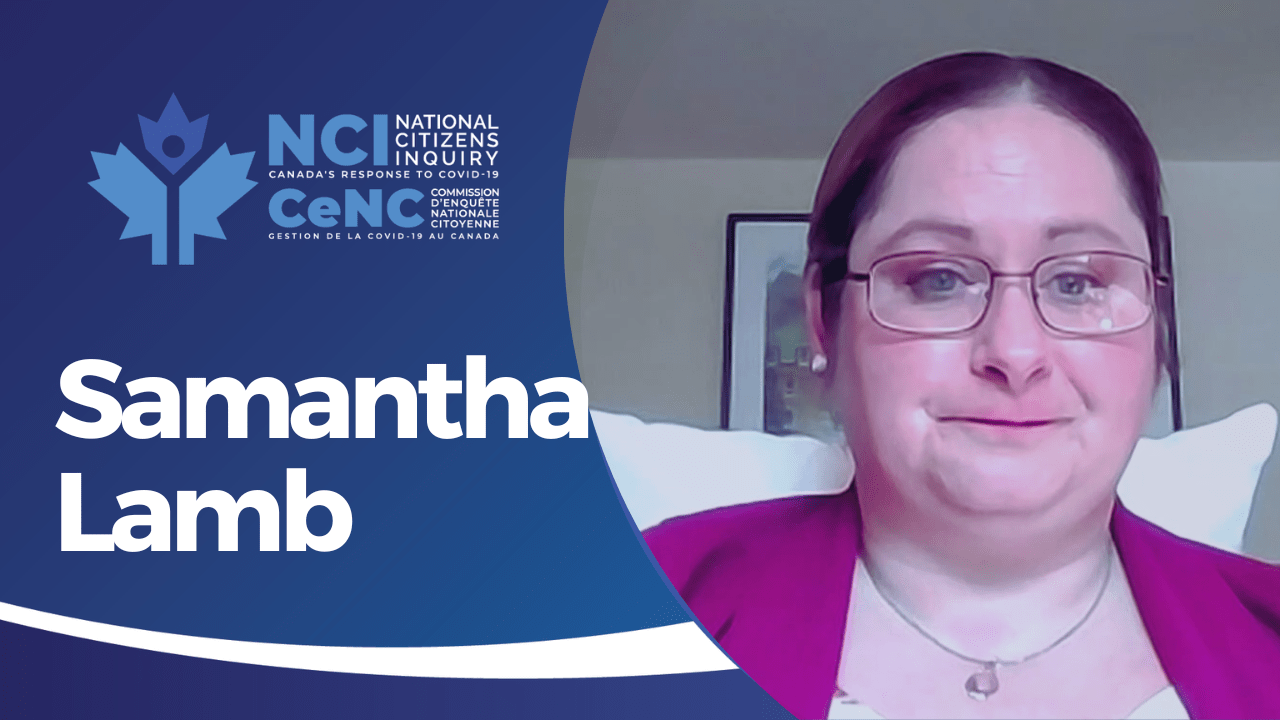Samantha Lamb describes the delays on longtime required surgery, truncated physiotherapy and resulting inability to work full-time and reduced pay due to the incomplete treatment that she received as direct consequences of the COVID shutdowns. When she was told her surgery was elective and not required, Samantha said, “I wasn’t capable of functioning. I wasn’t capable of taking care of my family. I wasn’t being able to be a mom of four kids. It’s really hard when mom breaks down.”
* The above video is being streamed via Rumble. Check back often as we continue to update the complete list of links to all witness testimonies in both video and audio/podcast formats.
[00:00:00]
Wayne Lenhardt
Okay. The next witness is Samantha Lamb. Oh, here we are. Samantha, can you hear me?
Samantha Lamb
Yes, I can hear you.
Wayne Lenhardt
Oh, there we are. Could you give us your name and then spell it? And then I’ll do an oath with you.
Samantha Lamb
Okay, my name is Samantha Lamb. It is spelled S-A-M-A-N-T-H-A L-A-M-B.
Wayne Lenhardt
Okay. And do you promise that the evidence you give today is the truth, the whole truth, and nothing but the truth, so help you?
Samantha Lamb
I do.
Wayne Lenhardt
We’re going to talk today about a spinal injury that you had. Maybe you could tell us exactly what happened and when this injury occurred.
Samantha Lamb
For sure. I’ve been experiencing low back degeneration for about 17 years. I’ve been managing it with chiropractic services and acupuncture. And then in 2018, close to 2019, something happened. I woke up one morning, I was in excruciating pain. I was trying to talk to my doctors about it. They just kept trying to send me to— I’ve tried physio. I had tried going to the spine clinic. I had done so many different things. At that point, we started trying spinal injections and finally it took my husband coming in and saying, “Look something’s really wrong.” Like I was— I couldn’t walk to the grocery store with him not pushing the cart, not doing anything other than just walking, without my feet going numb. And I couldn’t do any of the household chores, like it was— It would lay me right out. I would come home and have to just lay with my feet up.
So in about 2019, I finally took— I went to my workplace and said, “Look, I’m on all these medications. I’m not feeling good. I don’t feel like I should be here. What do I do?” My workplace was really amazing and wrote out a letter of description of my job duties, which— I’m an accounting officer for the credit union, SaskCentral, which is the central credit union for Saskatchewan. I took this letter to my doctor and she looked at the letter and said, “Yeah, based on this information, you should not be working.” We then pushed her to send a referral to a surgeon. I was seen pretty quickly in 2019, in December, by the surgeon. And within five minutes of being in his office he was like, “Why didn’t you come in sooner, what’s going on?” And I’m like, “I was told it wasn’t surgical.” And he’s like, “You need surgery.” So I’m like, “Okay.” So I signed the papers.
And then COVID hit and everything got shut down.
Wayne Lenhardt
Okay, so that was 2019.
Samantha Lamb
And 2020, yeah.
Wayne Lenhardt
2020.
Samantha Lamb
Yeah, I did finally receive my surgery. I got very upset and I actually sent a letter to my MLA. I sent a letter off to her, very upset, saying, “I’m a 40-year-old woman with four kids. I have a professional career and I’m stuck lying here on all these drugs because the healthcare system has been shut down.”
I did get a call back from her office. They did contact the advocacy for me, or the medical Saskatchewan advocacy, and within a month I had my surgery. So I did receive surgery in the end of May of 2021.
Wayne Lenhardt
Okay.
Samantha Lamb
But that was two and a half years of me waiting for surgery.
Wayne Lenhardt
Did you go and have some rehab work after that?
Samantha Lamb
Yeah. Well, that was the funny thing. So the rehab afterwards— With being on disability, I was at a point where disability was running out. I only had eight months left of my disability from my workplace before they were going to start sending me to CPP [Canada Pension Plan]. And they were sending threatening letters saying, you know, “If you don’t apply for Canadian pension or CPP disability, we’re going to assume that you have applied and we’re going to start deducting the amount from payments, from your current amount that you’re receiving.”
Wayne Lenhardt
Sure.
Samantha Lamb
And so I did apply for CPP disability. And they declined me because they called me a few days before my surgery and they said, “Well, if you’re getting surgery, then we’re not going to approve you because we don’t know what the outcome will be.”
But afterwards, that left me with only eight months to heal and get up to speed.
[00:05:00]
But out of those eight months, three of them, I wasn’t permitted to do any activity. I had to wait until the bones fused because I had a decompression and spinal fusion of the L5-S1 vertebrae.
I had to wait for the bone to fuse before I was allowed to do anything. And then, because of the delay in healthcare, I didn’t receive anybody to physically assess me. So even though my referrals were sent to Wascana Rehab that said that I was having trouble standing and so on, I only received a digital back class and digital therapy. So nobody actually looked at me, nobody assessed if I could get up, nobody could, nothing.
I called my disability plan and said, “You guys want me back to work. How am I supposed to do that with no disability? No physio, no nothing.” And so they did finally approve me for physiotherapy, which they were covering the cost of for me, to attend physio. And I needed physiotherapy in the water because my decompression and spinal fusion had taken so long that I needed to be in the water in order to do any physiotherapy. And so I went to an amazing physiotherapist, but that was about five and a half months after my surgery.
And so out of those eight months, five and a half, I was waiting to get in to someone.
Wayne Lenhardt
Okay.
Samantha Lamb
And that was a huge delay out of my healing time. I finally did get in to see the physiotherapist. And because of the rules, he performed his physiotherapy in the back of a gym. So because of the rules regarding entering a physical fitness center or any of those things, you had to show a vaccination pass. And I was very uncomfortable showing my medical information to anybody other than my doctors. So they had to sneak me in the back door and I kind of felt like a bit of a criminal going to physio. So it was like they didn’t really want me there, but yet they had to take me because they couldn’t deny me services. That’s not the way the clinic was, but it’s the way I felt because I had to be snuck in the back door in order to be seen by a physiotherapist, who wanted to help me.
After a week of physiotherapy, I caught COVID. So I was quarantined for 14 days. So out of the 12 weeks that I had before needing to go back to work and out of the physiotherapy, there goes two weeks. I was quarantined for 14 days. And then I went back to physio. We did a couple weeks and then he went to Mexico where— Again, because of the rules in Canada and the testing standards and everything else, even though he was vaccinated, even though he was boosted up and everything, he had no symptoms, but because he tested positive for COVID, he couldn’t come back for four weeks.
So out of the 6 weeks or 12 weeks that we should have been getting physio and he should be seeing what I’m doing, he had really only seen me for six weeks.
The disability didn’t care. He wrote an assessment saying, “Look, I haven’t been able to see her,” which led me to pay for a physical assessment. So I paid out of my own pocket to have him do a full physio assessment on me to see where I’m at. Can I stand? Can I sit? What are my capabilities? Which we sent off to disability and it proved that I can only sit and stand for no more than 100 minutes before requiring a lay-down break.
And I looked at him and I says, “Who’s going to hire me? How am I supposed to go back to work if I can’t sit or stand?” My work turned around and said, “We’ll accommodate her” because I could work from home. So we tried that. Within four weeks, they attempted to push me back to work within a four-week return to work up to full-time from a spine surgery.
I was just flabbergasted that they were trying so hard to get me back. And it’s because they wanted me off the books.
Wayne Lenhardt
Okay, so have your injuries now abated or are they still there?
Samantha Lamb
No. They’re still there. It’s almost two years after my spine surgery.
Because I was pushed back to work when I first started seeing physiotherapy. I was completely off all my medication, which meant that I felt like it was slowly working. I was healing, I wasn’t on any of the morphine or the nerve pain meds that I was on when I first started seeing physio.
[00:10:00]
And then the more I was pushed back to work, like, even my doctor— I had to keep going back to my doctor to get doctor’s notes to say I wasn’t ready to increase my hours, that my back wasn’t doing well. And the more I had to attempt to do full-time hours, the more I was in pain. And so the more I started having to go back slowly on certain medications and I was trying really hard to be on the ones that didn’t alter my mental capacity. Because being on all those medications: when you’re reconciling a banking system when you don’t have a memory recall, it’s really hard. And it makes it incapable of doing my job.
As they slowly pushed me back and I got up to about 80 per cent— But that took until October to get me up to 80 per cent and I was in tears. Like, I would literally go to work work for the 100 minutes and lie down for 30 minutes, work, lie down, work, lie down. Which then pushed my eight-hour day longer. Because these 30 minutes weren’t in my— I had to take them out of my personal time, which meant that I was scheduled for a longer day because I had to keep laying down for 30 minutes. And yes, I get two 15-minute breaks and a half-hour lunch, or an hour lunch, but then I’m having to work for longer days. And so by the time I was getting off my schedule, I was literally crawling back into bed. And it left me in bed. I couldn’t go anywhere.
I finally phoned my doctor and said, “This is not working, I should not be at work. This is not work. This is not value of life if I’m just going to work and going to bed.” She finally approved me back for disability. So now I’ve lost even more income because they restarted me on a new claim. They turned around and said, “Because you didn’t appeal your claim, we’re now going to assess you at the 80 per cent that you were capable of working and we’re only going to give you 70 per cent of that income.” So now I’m at less than half of my income because I wasn’t capable. And I was pushed too hard and too fast because I spent all my time waiting for surgery instead of getting time to heal.
Wayne Lenhardt
I see you appear to have a pillow behind you right now. So is your back still bothering you then? And how much and how often?
Samantha Lamb
My back is still bothering me every day. I’m now back on all of my medications that I was on before surgery. I’m on a nerve pain medication, I’m on an anti-inflammatory, I’m on a slow-release morphine for the pain. I am back on physio and I have been attempting physio but they’re seeing severe weakness on the left side of my body, which is where the pain was running down to begin with. And so that pain has not gone away and now I’m having hip and pelvic floor and bowel and all these other issues. So I’m finally being sent to a neurologist. But it’s been a very slow process and it’s almost two years after my surgery and I’m still not okay.
Wayne Lenhardt
Could you give us one or two things that could have been done differently along the way here that would have helped you?
Samantha Lamb
Well, I think if they wouldn’t have shut down all of the surgeries, I think that would have made a huge difference. I mean, I know I wasn’t in a place where I was critically hurt or my life was threatened—but because I was just suffering pain, I was placed on a backburner.
My surgery was labelled as being—what do you call it?—“elective,” saying that I wanted surgery and it wasn’t a requirement. Like I wasn’t dying, which— Yes, I wasn’t going to die from not being able to move my back but I wasn’t capable of working. I wasn’t capable of functioning. I wasn’t capable of taking care of my family. I wasn’t being able to be a mom of four kids. It’s really hard when mom breaks down.
Wayne Lenhardt
Okay, I’m going to ask the commissioners if anyone has any questions. Okay, I think that’s a no. So on behalf of the National Citizens Inquiry, thank you again for your testimony.
Samantha Lamb
Thank you.
[00:14:50]
Final Review and Approval: Jodi Bruhn, August 21, 2023.
The evidence offered in this transcript is a true and faithful record of witness testimony given during the National Citizens Inquiry (NCI) hearings. The transcript was prepared by members of a team of volunteers using an “intelligent verbatim” transcription method.
For further information on the transcription process, method, and team, see the NCI website: https://nationalcitizensinquiry.ca/about-these-transcripts/
Summary
Samantha Lamb is a wife and mother of four children who worked as an accounting officer for SAS Central (the central credit union for Saskatchewan). She required surgery due to escalating low back degeneration and pain. The surgery was delayed due to the COVID shutdowns but finally happened at the end of May 2021 with assistance by her MLA. She was approved for physiotherapy five and one-half months after the surgery with only a few months of disability left. She only received physio for six weeks out of the twelve-week session, due to having to quarantine after catching COVID, and her physiotherapist having to quarantine after returning from vacation.
She was pushed to go back to work and was accommodated by her employer by being allowed to work from home. Due to the healing not yet complete, it was impossible to work long periods of time without resting which stretched her workday out and required bed rest after working. She ended up receiving less than half her income with her disability being reduced. Almost two years after the surgery, Samantha is still experiencing pain, is on medications and can’t do physiotherapy. Now she has issues with her pelvic floor and bowels and has finally received a referral to a neurologist. She feels that surgeries should not have been shut down. Her surgery might have been considered elective, but she wasn’t capable of functioning and taking care of her family which is hard being a mom of four.






















